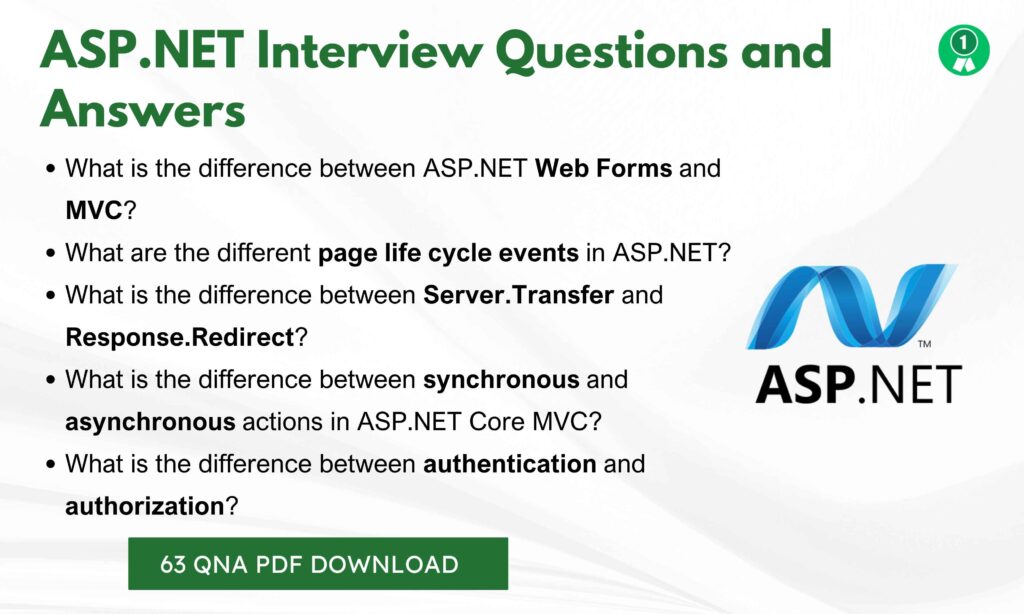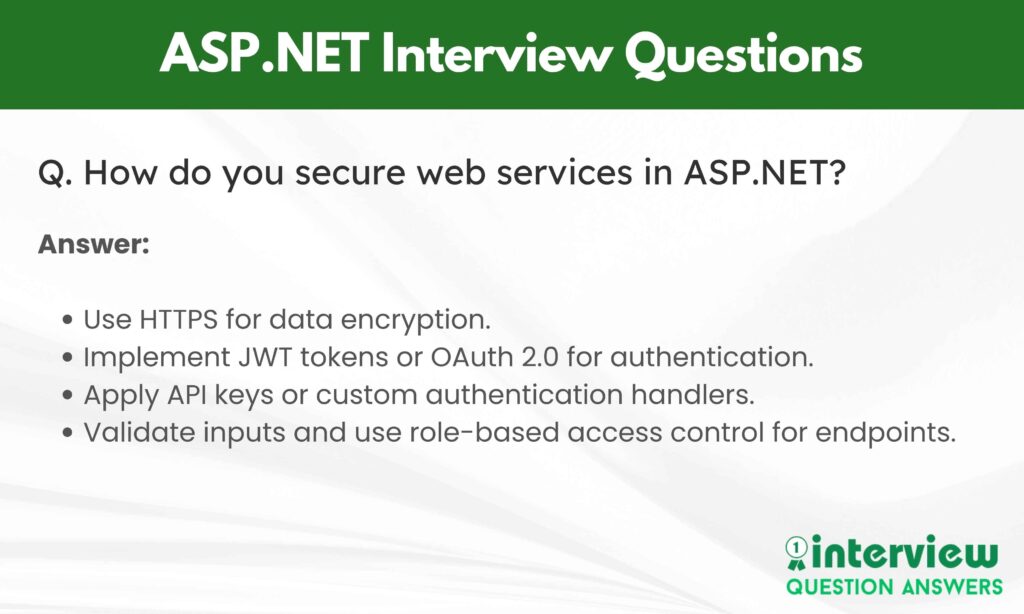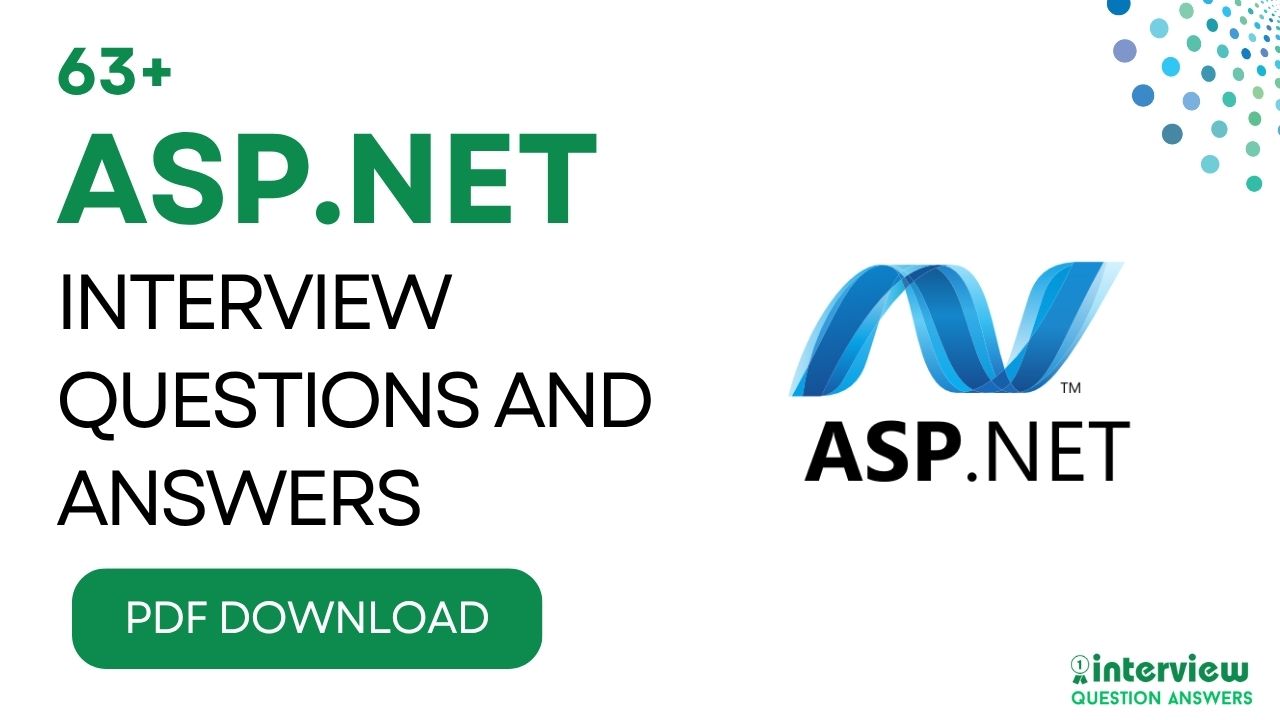ASP.NET is a powerful open-source web framework developed by Microsoft, used for building dynamic websites, web applications, and services. An ASP.NET developer is responsible for designing, developing, and maintaining scalable and secure web applications using technologies like C#, .NET Core, MVC, and Web API. These professionals work closely with frontend developers, database administrators, and testers to ensure seamless application performance across platforms.
With the shift toward cloud-native applications and the adoption of ASP.NET Core, employers are actively seeking developers who have hands-on experience in both traditional ASP.NET and its modern iterations.
Understanding the types of ASP.NET interview questions that recruiters and technical leads ask is crucial. Interviews typically focus on core ASP.NET concepts, MVC architecture, state management, Web APIs, security practices, and real-world problem-solving scenarios.
This guide includes a complete set of ASP.NET Interview Questions and Answers for both freshers and experienced candidates, along with a strong focus on core ASP.NET concepts.
Table of Contents
ASP.NET Interview Questions & Answers for Freshers
Que 1. What is the difference between ASP.NET Web Forms and MVC?
Answer:
- Web Forms: Event-driven, uses server controls and ViewState, suitable for rapid development.
- MVC: Follows Model-View-Controller architecture, offers better separation of concerns and control over HTML.
MVC is preferred for testability and modern web applications.
Que 2. What are the main features of ASP.NET Core?
Answer:
- Cross-platform support (Windows, macOS, Linux)
- High performance and lightweight
- Built-in dependency injection
- Unified framework for MVC and Web API
- Side-by-side versioning and modular components
Que 3. What are the different page life cycle events in ASP.NET?
Answer:
- Page_Init – Initialization of controls
- Page_Load – Page loads with control values
- Page_PreRender – Final changes before rendering
- Page_Unload – Page cleanup after rendering
Que 4. What is the difference between ViewData, ViewBag, and TempData?
Answer:
| Feature | ViewData | ViewBag | TempData |
|---|---|---|---|
| Type | Dictionary | Dynamic property | Dictionary |
| Lifetime | Current request | Current request | Current and next request |
| Usage | ViewData[“key”] | ViewBag.key | TempData[“key”] |
Que 5. What is the Global.asax file used for?
Answer: It contains application-level events such as Application_Start, Session_Start, Application_Error, etc. It’s used for configuration, logging, and application initialization.
Que 6. What is the difference between Server.Transfer and Response.Redirect?
Answer:
- Server.Transfer: Transfers request on the server side without a round trip; faster.
- Response.Redirect: Sends a new request to the browser; visible URL change and slower.
Que 7. How do you perform state management in ASP.NET?
Answer:
- Client-side: Query strings, cookies, ViewState, hidden fields.
- Server-side: Session state, application state, cache, database.
Que 8. What is the difference between synchronous and asynchronous actions in ASP.NET Core MVC?
Answer:
- Synchronous: Blocks the thread until the task completes.
- Asynchronous: Uses async and await to free up threads, improving scalability and performance.
Que 9. What are Razor pages in ASP.NET Core?
Answer: Razor Pages is a page-based model for building web applications. It uses .cshtml files with embedded C# code and supports better separation of UI and logic without the full MVC pattern.
Que 10. How can you prevent Cross-Site Request Forgery (CSRF) in ASP.NET Core?
Answer:
- Use the built-in @Html.AntiForgeryToken() in forms.
- Enable ValidateAntiForgeryToken attribute in controllers.
- Ensure token validation in every request that modifies data.
Que 11. What is middleware in ASP.NET Core?
Answer: Middleware are software components in the request pipeline that handle requests and responses. Examples: authentication, logging, routing. They are configured in Startup.cs using app.Use…() methods.
Que 12. What is the difference between authentication and authorization?
Answer:
- Authentication: Verifies the identity of a user (e.g., username/password).
- Authorization: Determines what resources the user can access after authentication.
Que 13. How can you connect an ASP.NET Core application with a database?
Answer:
- Use Entity Framework Core for ORM-based database interaction.
- Configure the connection string in appsettings.json.
- Register DbContext in Startup.cs using services.AddDbContext<>().
Que 14. What are Tag Helpers in ASP.NET Core?
Answer: Tag Helpers allow server-side code to participate in creating and rendering HTML elements in Razor files.
Example: <form asp-action=”Submit”>generates the correct form action URL dynamically.
Que 15. How do you enable routing in ASP.NET Core MVC?
Answer:
- Use app.UseRouting() in Startup.cs.
- Define routes using app.UseEndpoints(endpoints => { endpoints.MapControllerRoute(…); }).
- Use attribute routing with [Route(“path”)] in controllers.
Que 16. What are Filters in ASP.NET MVC/Core?
Answer: Filters are attributes that allow logic to be executed before or after controller actions. Types include:
- Authorization filters
- Action filters
- Result filters
- Exception filters
Que 17. What is dependency injection, and how is it implemented in ASP.NET Core?
Answer: DI is a design pattern for achieving loose coupling. In ASP.NET Core, services are registered inStartup.cs (services.AddScoped()) and injected into constructors of dependent classes.
Que 18. How do you log errors in ASP.NET Core?
Answer:
- Use the built-in logging framework (ILooger).
- Configure providers (Console, Debug, Application Insights, Serilog).
- Use
try-catchwith logging inside catch blocks.
Que 19. What is Kestrel in ASP.NET Core?
Answer: Kestrel is a cross-platform web server used by ASP.NET Core applications. It’s lightweight, high-performance, and can be used standalone or behind a reverse proxy like IIS or Nginx.
Que 20. How do you secure an ASP.NET Core application?
Answer:
- Implement authentication (JWT, Identity).
- Use HTTPS and data encryption.
- Enable CSRF protection and input validation.
- Set proper authorization policies and roles.
- Keep dependencies updated and scan for vulnerabilities.

Also Check: C# Interview Questions and Answers
ASP.NET Core Interview Questions & Answers
Que 21. What are the key differences between ASP.NET Core and ASP.NET Framework?
Answer:
- ASP.NET Core is cross-platform (Windows, macOS, Linux) while ASP.NET Framework is Windows-only.
- Core is modular and lightweight, Framework is monolithic.
- ASP.NET Core supports dependency injection natively.
- Core provides unified MVC + Web API, Framework separates them.
Que 22. How do you configure services in ASP.NET Core?
Answer: Services are registered in the Startup.cs class using the ConfigureServicesmethod:
public void ConfigureServices(IServiceCollection services)
{
services.AddControllersWithViews();
services.AddScoped<IMyService, MyService>();
}This allows them to be injected into controllers or other classes.
Que 23. What is the use of appsettings.json in ASP.NET Core?
Answer: It stores configuration data like connection strings, API keys, and application settings. It supports hierarchical data in JSON format and can be overridden by environment-specific files (e.g., appsettings.Development.json).
Que 24. How is routing handled in ASP.NET Core?
Answer: ASP.NET Core uses endpoint routing:
app.UseRouting();
app.UseEndpoints(endpoints =>
{
endpoints.MapControllerRoute(
name: "default",
pattern: "{controller=Home}/{action=Index}/{id?}");
});It also supports attribute routing using [Route(“path”)].
Que 25. What are the different lifetimes in dependency injection in ASP.NET Core?
Answer:
| Lifetime | Description |
|---|---|
| Singleton | Created once and shared throughout the application |
| Scoped | Created once per HTTP request |
| Transient | Created every time it is requested |
Que 26. What are Middleware components in ASP.NET Core?
Answer: Middleware are components that process requests and responses in a pipeline. Examples include authentication, routing, exception handling, and logging. They are added in Startup.cs using methods like app.UseAuthentication() or app.UseEndpoints()..
Que 27. How do you handle exceptions in ASP.NET Core applications?
Answer:
- Use built-in middleware:
app.UseExceptionHandler("/Home/Error");
app.UseHsts();- Implement custom middleware for error handling.
- Use logging providers (Serilog, NLog) to capture errors.
Que 28. What are Tag Helpers and how are they used?
Answer: Tag Helpers let server-side code participate in creating HTML elements. Example:
<form asp-controller="Home" asp-action="Submit">
<input asp-for="UserName" />
</form>This generates correct controller/action URLs dynamically.
Que 29. What is Kestrel and how does it work with IIS?
Answer: Kestrel is ASP.NET Core’s built-in web server. It can run as a standalone server or behind IIS/Nginx (reverse proxy) for security and load balancing. In production, IIS forwards requests to Kestrel.
Que 30. How do you implement authentication in ASP.NET Core?
Answer:
- Use ASP.NET Core Identity for user management.
- Use JWT (JSON Web Tokens) for API authentication.
- Configure authentication schemes in
Startup.cs:
services.AddAuthentication(JwtBearerDefaults.AuthenticationScheme)
.AddJwtBearer(...);Que 31. How do you secure sensitive data in ASP.NET Core?
Answer:
- Store secrets in Secret Manager or Azure Key Vault.
- Use HTTPS for data transmission.
- Encrypt connection strings.
- Use Data Protection API for cookies and tokens.
Que 32. What is the difference between IConfiguration and IOptions?
Answer:
- IConfiguration: Accesses configuration settings directly using keys.
- IOptions: Maps configuration values to strongly typed classes.
Example:
services.Configure<MyConfig>(Configuration.GetSection("MyConfig"));Que 33. How do you perform logging in ASP.NET Core?
Answer:
- Use built-in ILogger<t> dependency injection.
- Configure logging providers in Program.cs:
builder.Logging.AddConsole();
builder.Logging.AddDebug();- Popular third-party loggers: Serilog, NLog, ELK stack.
Que 34. What are Razor Pages and when should you use them?
Answer: Razor Pages is a page-based model for building web apps without full MVC architecture. It is best for applications where each page has a self-contained logic, reducing boilerplate code.
Que 35. How do you deploy an ASP.NET Core application?
Answer:
- Windows: Deploy to IIS using the ASP.NET Core Hosting Bundle.
- Linux: Deploy to Nginx or Apache as a reverse proxy with Kestrel.
- Cloud: Deploy to Azure App Services, AWS Elastic Beanstalk, or Docker containers.
Deployment involves publishing via Visual Studio, CLI, or CI/CD pipelines.
Also Check: Web API Interview Questions and Answers
ASP.NET Interview Questions & Answers for 5 Years Experienced
Que 36. What are the main differences between ASP.NET Web Forms and ASP.NET MVC?
Answer:
- ASP.NET Web Forms: Event-driven, uses server controls, and ViewState, suitable for rapid UI development.
- ASP.NET MVC: Follows Model-View-Controller architecture, promotes testability, and provides more control over HTML/CSS.
MVC is generally preferred for large, scalable web applications.
Que 37. How do you handle session state in ASP.NET for distributed applications?
Answer:
- Use State Server or SQL Server mode for centralized session management.
- Implement a distributed cache like Redis.
- Avoid using InProc session state for load-balanced applications.
Que 38. What is the difference between caching techniques available in ASP.NET?
Answer:
| Cache Type | Description |
|---|---|
| Output Caching | Caches the whole page response |
| Data Caching | Stores application data in memory for quick access |
| Fragment Caching | Caches portions of a page (user controls) |
Que 39. How do you secure ASP.NET applications against SQL Injection?
Answer:
- Use parameterized queries or stored procedures.
- Avoid dynamic SQL string concatenation.
- Validate and sanitize user inputs.
Example:
SqlCommand cmd = new SqlCommand("SELECT * FROM Users WHERE Id=@Id", conn);
cmd.Parameters.AddWithValue("@Id", userId);Que 40. How do you implement custom error handling in ASP.NET?
Answer:
- Use try-catch blocks for granular handling.
- Define in web.config.
- Use Application_Error in Global.asax for global error handling.
- Implement logging using log4net, NLog, or ELMAH..
Que 41. How do you optimize performance in ASP.NET applications?
Answer:
- Enable caching and output compression.
- Minimize ViewState size.
- Use asynchronous calls for long-running tasks.
- Optimize database queries and use connection pooling.
Que 42. How do you handle Cross-Site Scripting (XSS) in ASP.NET?
Answer:
- Encode output using HttpUtility.HtmlEncode.
- Use anti-XSS libraries or built-in ASP.NET request validation.
- Avoid directly rendering user inputs without sanitization.
Que 43. What is the difference between Server.Transfer and Response.Redirect, and when to use each?
Answer:
- Server.Transfer: Transfers execution on the server without changing the URL; faster.
- Response.Redirect: Sends a new HTTP request and changes the browser URL; useful for redirecting to external URLs.
Que 44. How do you implement Dependency Injection in ASP.NET applications?
Answer:
- Use IoC containers like Unity, Autofac, or Ninject.
- Register dependencies in Global.asax or a startup class.
Example using Unity:
container.RegisterType<IService, Service>();
DependencyResolver.SetResolver(new UnityDependencyResolver(container));Que 45. What are HTTP Modules and HTTP Handlers in ASP.NET?
Answer:
- HTTP Handlers: Process individual HTTP requests (e.g., serving images).
- HTTP Modules: Intercept and modify requests/responses during the pipeline.
They are configured in web.config.
Que 46. How do you manage authentication and authorization in ASP.NET?
Answer:
- Implement Forms Authentication or integrate with Windows Authentication.
- Use ASP.NET Membership Provider or Identity.
- Apply role-based or claims-based authorization using attributes like [Authorize(Roles=”Admin”)].
Que 47. How do you configure web applications for deployment in IIS?
Answer:
- Set correct application pool (.NET version).
- Ensure necessary permissions on the application folder.
- Configure web.config for production settings (connection strings, error handling).
- Enable SSL if required.
Que 48. What are the key differences between ViewData, ViewBag, and TempData in ASP.NET MVC?
Answer:
| Feature | ViewData | ViewBag | TempData |
|---|---|---|---|
| Type | Dictionary | Dynamic property | Dictionary |
| Lifetime | Current request only | Current request only | Current + next request |
| Usage | ViewData[“key”] | ViewBag.key | TempData[“key”] |
Que 49. How do you implement asynchronous controllers in ASP.NET MVC?
Answer:
- Use async and await keywords in action methods.
- Return Task <ActionResult> from the controller.
Example:
public async Task<ActionResult> GetData()
{
var data = await service.GetDataAsync();
return View(data);
}Que 50. How do you secure web services in ASP.NET?
Answer:
- Use HTTPS for data encryption.
- Implement JWT tokens or OAuth 2.0 for authentication.
- Apply API keys or custom authentication handlers.
- Validate inputs and use role-based access control for endpoints.

Also Check: Full Stack Developer Interview Questions PDF
ASP.NET Interview Questions & Answers for 10 Years Experienced
Que 51. How do you design scalable ASP.NET applications for enterprise-level workloads?
Answer:
- Use N-tier architecture to separate UI, business logic, and data access.
- Implement load balancing with web farms or cloud scaling.
- Use distributed caching (e.g., Redis, NCache) to reduce database load.
- Ensure async programming and message queues (Azure Service Bus, RabbitMQ) for background tasks.
Que 52. How do you handle distributed session management in load-balanced ASP.NET applications?
Answer:
- Use SQL Server Session State or State Server for centralized session management.
- Leverage distributed caches like Redis for session state.
- Avoid large session objects and prefer token-based (stateless) approaches for better scalability.
Que 53. How do you implement advanced security measures in ASP.NET applications?
Answer:
- Enable HTTPS and HSTS.
- Use OWASP guidelines for XSS, CSRF, SQL Injection prevention.
- Implement token-based authentication (JWT, OAuth 2.0) and claims-based authorization.
- Use Data Protection API for encrypting sensitive data and secure cookie handling.
Que 54. What caching strategies would you use for high-performance ASP.NET apps?
Answer:
| Caching Type | Usage |
|---|---|
| Output Caching | Cache complete pages for anonymous users |
| Data Caching | Store frequently accessed data (DB results) |
| Distributed Cache | Share cache across multiple servers |
| MemoryCache | In-memory cache for single-server apps |
Que 55. How do you debug and profile performance issues in production ASP.NET applications?
Answer:
- Use Application Insights, ELMAH, or Serilog for logging and monitoring.
- Profile with tools like dotTrace, ANTS Profiler, or PerfView.
- Check slow database queries, memory leaks, and thread contention.
- Enable MiniProfiler or custom instrumentation for critical endpoints.
Que 56. How do you manage large-scale configuration across multiple environments?
Answer:
- Use web.config transforms for environment-specific settings.
- Store secrets in Azure Key Vault or AWS Secrets Manager.
- Centralize configuration in distributed configuration systems (Consul, etcd).
- Automate deployment using CI/CD pipelines with parameterized configs.
Que 57. What strategies do you use for database connection management and optimization?
Answer:
- Use connection pooling and close connections promptly.
- Implement caching layers to reduce database hits.
- Use async database operations for scalability.
- Optimize queries and indexes, and avoid N+1 query problems using ORM tools like Entity Framework.
Que 58. How do you design and consume Web APIs in ASP.NET for large ecosystems?
Answer:
- Use versioning strategies (URL, query string, header-based).
- Ensure proper throttling and rate-limiting for external consumers.
- Document APIs using Swagger/OpenAPI.
- Implement security with OAuth 2.0, API keys, and scopes.
Que 59. What is your approach to designing a fault-tolerant ASP.NET application?
Answer:
- Implement circuit breakers and retry policies using libraries like Polly.
- Design for graceful degradation and failover.
- Use redundant services and geo-replication.
- Ensure proper exception handling and fallback mechanisms in critical paths.
Que 60. How do you integrate ASP.NET applications with microservices?
Answer:
- Use REST or gRPC for inter-service communication.
- Implement service discovery and load balancing in microservices architecture.
- Handle distributed transactions using sagas or event-driven architecture.
- Centralize logging and monitoring across services using ELK, Azure Monitor, or Splunk.
Que 61. How do you manage CI/CD for enterprise ASP.NET projects?
Answer:
- Use Azure DevOps, Jenkins, or GitHub Actions for automated builds and deployments.
- Run unit, integration, and automated UI tests in pipelines.
- Implement blue-green or canary deployments for zero downtime.
- Enforce code quality gates using SonarQube or similar tools.
Que 62. How do you secure communication between ASP.NET services and databases?
Answer:
- Enforce TLS for all network traffic.
- Use managed identities (Azure AD) or service accounts with least privilege.
- Encrypt sensitive data at rest using TDE (Transparent Data Encryption).
- Enable firewall rules and VPNs for database access control.
Que 63. How do you modernize legacy ASP.NET Web Forms applications?
Answer:
- Break monoliths into microservices or modular components.
- Upgrade to ASP.NET Core where possible.
- Replace ViewState-heavy pages with lightweight MVC or Razor Pages.
- Introduce API-driven frontends (Angular, React) gradually for modern UX.
Also Check: SQL interview questions and Answers
ASP.NET Interview Questions PDF
You can also download the PDF file to study anywhere without internet. Use this guide to practice and improve your chances of getting an ASP.NET developer job.
FAQs: ASP.NET Interview Questions
What is the typical job role of an ASP.NET Core Developer?
An ASP.NET Core Developer is responsible for building, maintaining, and deploying scalable web applications using Microsoft’s ASP.NET Core framework. They design APIs, work with databases, integrate front-end technologies, and ensure security, performance, and maintainability of applications.
What challenges can one face in an ASP.NET Core job?
Common challenges include designing scalable architecture, optimizing performance, managing dependency injection effectively, ensuring security (authentication, authorization), and maintaining code quality in large projects. They may also face issues with cloud deployments and continuous integration.
What challenges might candidates face during an ASP.NET Core interview?
Candidates often face questions about middleware, dependency injection, REST API design, Entity Framework Core, and asynchronous programming. They may also be asked to solve coding challenges or design system-level solutions using ASP.NET Core best practices.
What is the average salary of an ASP.NET Core Developer in the USA?
The average salary for an ASP.NET Core Developer in the USA ranges from $95,000 to $130,000 per year, depending on experience, location, and company. Senior developers or full-stack ASP.NET Core engineers can earn upwards of $140,000 annually.
What skills are required to succeed in an ASP.NET Core development role?
Developers need a strong understanding of C#, ASP.NET Core MVC, Web APIs, Entity Framework Core, and SQL. Knowledge of cloud platforms (Azure/AWS), containerization (Docker, Kubernetes), front-end frameworks (Angular/React), and CI/CD pipelines is highly beneficial.
Which top companies hire ASP.NET Core Developers?
Top companies include Microsoft, Amazon, IBM, Accenture, Infosys, TCS, Deloitte, and Capgemini. Many enterprise product-based companies and SaaS startups rely heavily on ASP.NET Core for backend development.
How can you grow your career as an ASP.NET Core Developer?
Career growth comes from mastering advanced ASP.NET Core features, contributing to architecture design, and learning microservices, cloud-native development, and DevOps practices. Certifications like Microsoft Azure Developer and transitioning to roles like Software Architect or Technical Lead can boost career progression.
Conclusion
This ASP.NET interview questions guide includeds questions about basic ASP.NET programming and core concepts that companies ask about. The page covers everything from freshers to experienced questions and answers that employers want to ask.







